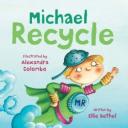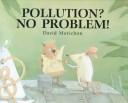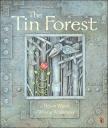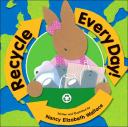The following resources are appropriate to begin teaching first graders to become conscientious environmental advocates (Virginia Science SOL 1.8). These resources, including pertinent literature and websites for both students and educators, help highlight the potential consequences of poor environmental stewardship and the positive impact that all students can have if they reduce, reuse, and recycle.
Relevant Children’s Literature:
Michael Recycle
Written by Ellie Bethel
Illustrated by Alexandra Colombo
“There once was a town
Called Abberdoo-Rimey,
Where garbage was left
To grow rotten and slimy.”
So begins the story of a garbage heap of a town that is saved by the surprising presence of a child super hero- Michael Recycle. Entertaining as well as educational, the presence of Michael, a young boy, as the town’s savior empowers children to believe that they too have the ability to affect a change. In that vein, the end of the book lists several green strategies everyone can implement. For example, “Quick and Clean! Take shorter showers… unless you are really, really smelly.”
Pollution? No Problem!
Written and Illustrated by David Morichon
Albert believes his invention will make his life easier… that is until it begins seeping a purple goo. Albert and his friend Henry spend the rest of the book trying to get rid of the goo, but to no avail. Albert tries everything, from burying the goo down deep, to sending it into outer space, but the goo always finds its way back to earth. The boys quickly learn that when you throw something away, it does not just disappear. Albert’s journey is a great lead into a discussion about where our garbage goes when we throw it away (a landfill) and the consequences of the improper disposal of trash.
The Tin Forest
Written by Helen Ward
Illustrated by Wayne Anderson
An old man lives alone in the midst of a garbage heap. He dreams of jungles and living animals to keep him company, and finally one day slowly begins to create the jungle of his dreams with the garbage and tin surrounding him. His tin forest attracts the attention of a real bird, who brings a friend, and a seed. Slowly, the tin forest makes way for a real wilderness.
A story about imagination and the power of dreaming, The Tin Forest is also a great jumping off point to talk about the power of restoration. Considered by some to be the fourth “R”, to restore is to take something and bring it back to life. The old man sees the potential beneath the trash, and his effort restores life to his surroundings.
The Lorax
Written and Illustrated by Dr. Seuss
The Once-ler cuts down all of the Truffula trees, destroying the habitat of such fanciful animals as the Brown Bar-Ba-Loots, Humming Fish, and Swomee Swans. The Lorax continually tries to “speak for the trees” but is ignored by the Once-ler until it is too late. All of the animals are forced to travel away, leaving only the Once-ler to preach this cautionary tale about irresponsibly taking with no thought to the environmental consequences.
For more resources on teaching The Lorax, visit Lorax Project.
Recycle Every Day!
Written and Illustrated by Nancy Elizabeth Wallace
Minna is a young rabbit who is excited to enter a contest at school to create a recycling poster. The winning poster will be put in the Community Recycling Calendar! Minna can not decide what to make her poster about, and as she looks around for inspiration, is surprised by all of the little things that her family does everyday to make a difference. All of these small things add up to make a big difference, causing Minna to create the poster, “Re-re-remember. Re-re-recycle Every Day!” Using found and recycled objects to create the art for the book, Nancy Wallace shows the students how important it is to Reduce, Reuse, and Recycle at every possible opportunity.
Relevant Websites for Students
I would recommend this fun, age appropriate game as part of a center rotation after a whole class reading and discussion of Michael Recycle. Although the game is not affiliated with the book, it is a nice extension about appropriate waste disposal, and the positive impact that every student can have on the environment.
The game is a maze, in which the student fights against the clock to collect 10 pieces of litter and then place them in the proper disposal receptacles. Very fun and user friendly!
A very neat quiz, testing students knowledge of how they can dispose of trash, without throwing it away. There are 30 items, ranging from leaves to a rocking chair, that students must decide to either recycle, compost, give to charity, or put in the trash. At the end of the quiz, the students are told what answers they did not get correct, and are given the opportunity to try again.
Hopefully students will be inspired by the message behind the RRR unit, and will take some of their new found passion home with them. This website has fun activities that students and parents can do together to begin being more earth friendly at home. Examples of initiatives are composting and creating recycled paper.
Twenty-five minutes in length, this animated movie of the Dr. Seuss classic incorporates songs (whose lyrics are also written by Dr. Seuss) into the original story line. An engaging way to show the impactful story in another format, perhaps as a center rotation.
The Green Family is all about taking care of the environment. Watch their informative episodes, or click on this link to play games that reinforce their environmental message! “Lights Out” reminds us to turn the lights out when we leave a room, and “Thrifty Threads” allows you to redesign old clothes to give to charity.
Helpful Resources for Educators
Before it became Recycle City, it was a disastrously dirty town known as Dumptown. In order to clean up Dumptown, you need to research several clean up options, and choose the most efficient and cost effective ones to clean up the town. While the language in this game is far beyond a first grade level, it would be a fun whole class activity to look at each of the options, and discuss the impacts on the town. The students will enjoy seeing the town clean up before their very eyes as their decisions affect positive change.
Garbage: How Can My Community Reduce Waste?
This website is extremely informative and user friendly, giving background on the nature and disposal of all types of waste, from hazardous waste, to sewage and solid waste. The website also shows a global prospective, and the importance of sustainability for the future. This website would be especially helpful to look at before reading and discussing Pollution? No Problem! with a class.
A fun way to show students first hand the possibilities of reusing. Ask parents to send in any old CD cases, and you have an earth friendly, and inexpensive project, perhaps for Mother’s or Father’s Day.
Full of lesson plans and printables to help teach recycling, this website is very easy to navigate and has a wealth of knowledge for educators teaching this unit.





